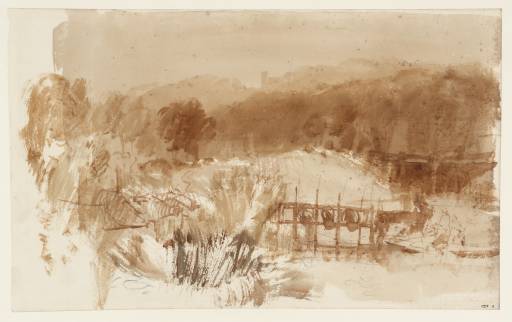Joseph Mallord William Turner A River Scene with Eel Traps c.1807-19
Joseph Mallord William Turner,
A River Scene with Eel Traps
c.1807-19
Joseph Mallord William Turner 1775–1851
A River Scene with Eel Traps circa 1807–19
D08086
Turner Bequest CXV 3
Turner Bequest CXV 3
Pencil and watercolour on white wove lightweight writing paper, 231 x 377 mm
Watermark ‘J Whatman | 1807’
Inscribed by John Ruskin in red ink ‘3’ bottom right
Blind-stamped with Turner Bequest monogram bottom right
Stamped in black ‘CXV 3’ bottom right
Watermark ‘J Whatman | 1807’
Inscribed by John Ruskin in red ink ‘3’ bottom right
Blind-stamped with Turner Bequest monogram bottom right
Stamped in black ‘CXV 3’ bottom right
Accepted by the nation as part of the Turner Bequest 1856
Exhibition history
1951
Loan of Turner Watercolours from the British Museum, Camberwell School of Arts and Crafts, London, May–June/July 1951 (no catalogue).
1982
Turner in the Open Air: Watercolours from the Turner Bequest, Loaned by the British Museum, Tate Gallery, London, July–December 1982 (no catalogue).
1989
Turner: The Second Decade: Watercolours and Drawings from the Turner Bequest 1800–1810, Tate Gallery, London, January–March 1989 (25, reproduced, and in colour p.12, as circa 1806).
References
1909
A.J. Finberg, A Complete Inventory of the Drawings of the Turner Bequest, London 1909, vol.I, p.314, CXV 3, as ‘River scene, with eel traps’, circa 1809–10.
1974
Gerald Wilkinson, The Sketches of Turner, R.A. 1802–20: Genius of the Romantic, London 1974, p.111, reproduced p.112 (colour).
1996
Gillian Forrester, Turner’s ‘Drawing Book’: The Liber Studiorum, exhibition catalogue, Tate Gallery, London 1996, p.24 note 81.
The setting for this undeveloped sketch is unidentified – if not imaginary – though probably based on observation in the backwaters of the Thames; the tower of a church or castle appears on the horizon. One set of traps forms the focus of the composition, though there is another less prominent group at an angle to the left. In the middle distance to the right, a pencilled-in bridge seems to have been altered with a dark wash into a set of lock gates. There are at least two figures in the foreground, indicated in wash outline; one possibly holds a fishing rod.
An eel trap is prominent in the foreground of an otherwise unrelated watercolour in the Thames, from Reading to Walton sketchbook of 1805 (Tate D05913; Turner Bequest XCV 13); another sketch in the same book (T05940; XCV 36), shows figures in a punt, possibly in pursuit of eels. Eel pots appear in Thames studies in the Tabley Sketchbook, No.3 (Tate D07130; Turner Bequest CV 92), and eel-catching is shown in the later Walmer Ferry sketchbook (Tate D10662; Turner Bequest CXLII 10). Turner was himself a keen fisherman, and frequently depicted river- and sea-fishing.1 In the absence of specific evidence, the span of the Liber Studiorum’s active publication, 1807–19, is given here as a date range for the present work (as it is for various other unpublished designs). The earlier published date of circa 1806 is clearly not viable given the sheet’s 1807 watermark. Studies made on adjacent pages probably also show or are derived from Thames scenery: see Tate D08084, D08085, D08087, D08088; Turner Bequest CXV 1, 2, 4, 5).2
Technical notes:
The left and lower edges are free of colour. Turner’s pencil work is here largely limited to the defining the eel traps and the bridge or lock beyond. The washes include brown ochre, Indian red, Mars red and sepia shades, the latter prominent in indicating scrubby vegetation in the foreground. The background washes were done on with the paper wetted.1
This sheet was recorded by Finberg in 1909 as apparently still being in the sketchbook, but if so it was subsequently removed before the book was badly damaged by immersion in the basement of the Tate Gallery during the Thames flood of January 1928. His number, ‘3’, corresponds with the red ink folio numbers inscribed in the book by Ruskin. The whole sheet was taken from the book, leaving no stub, and then trimmed slightly irregularly at the left-hand edge to remove the stitching holes, their vestiges being just apparent.
Verso:
Blank, save for inscriptions.
Inscribed in pencil ‘3’ top right
Stamped in black ‘CXV 3’ bottom left
Stamped in black ‘CXV 3’ bottom left
There are a few spots of wash, offset from the next composition in the sketchbook (Tate D08087; Turner Bequest CXV 4).
Matthew Imms
May 2006
How to cite
Matthew Imms, ‘A River Scene with Eel Traps c.1807–19 by Joseph Mallord William Turner’, catalogue entry, May 2006, in David Blayney Brown (ed.), J.M.W. Turner: Sketchbooks, Drawings and Watercolours, Tate Research Publication, December 2012, https://www

